Headlines are an important part of any website's content strategy, as they can help draw in readers and boost search engine rankings. Effective headlines require creativity, curiosity, and an understanding of basic SEO principles. AI tools can help with that.
Australian blogger Darren Rowse’s ’21 Settings, Techniques and Rules All New Camera Owners Should Know’ is one of the most viral blogs. Why do you think it has reached so many audiences?
Of course, the blog has valuable, well-written, and high-quality content. But that’s not the only deciding factor. It is the headline that first draws attention. It drives action and prompts the reader to read the blog further. This is the power of an attractive headline!
People judge a book by its cover. A blog, article, e-mail, or any content piece is the book, and its headline is the cover. If the headline is dry and dull, there will be no clicks, traffic, or engagement.
An important success factor of headline writing is SEO. Most searchers type only a few words in their search queries to get the top results. SEO helps to match these words with the headline.
If there’s a proper match, then SEO boosts the search engine ranking of the content and helps it gain more visibility. Thus, a search engine-optimized title can make the content go viral.
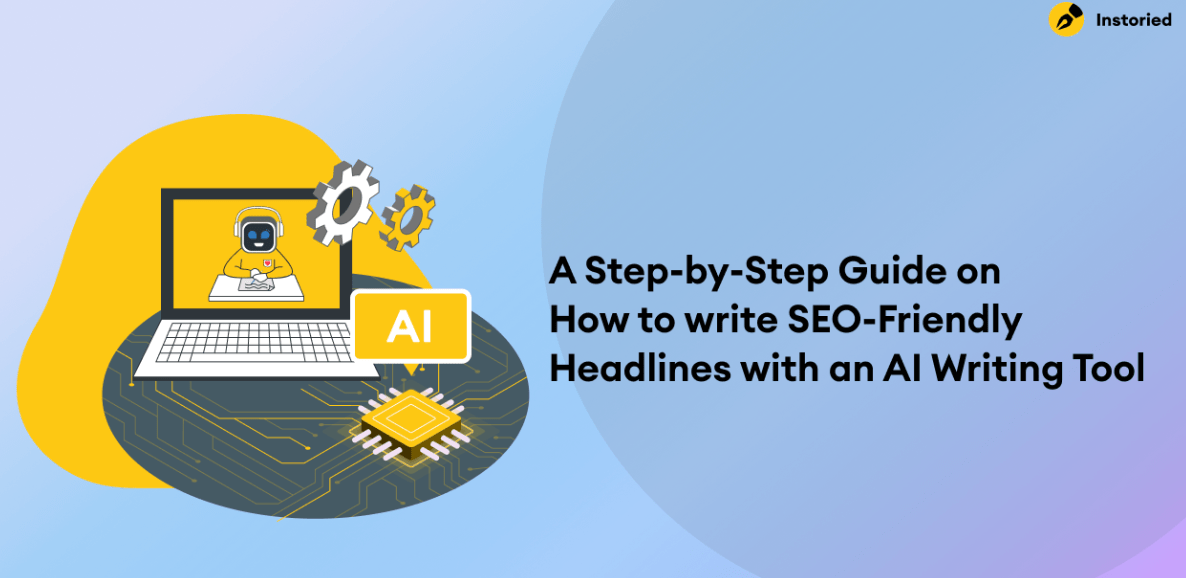
In this blog, you’ll learn how to make your marketing headlines search engine optimized to gain more traffic and engagement.
Hire a trusted SEO firm to assist with your company's content.
What’s an SEO Headline?
An SEO headline is the first call to action on your webpage that’s visible to readers as well as search engines. It should be well-differentiated and optimized for humans and crawlers to recognize it as a headline.
Thus, before understanding the rules of headline writing, you should know about the two elements of SEO that influence a headline:
H1 Tag
An HTML heading is the first header tag visible on a page. The heading tag optimization helps search engines to understand what type of content the page contains and rank it accordingly.
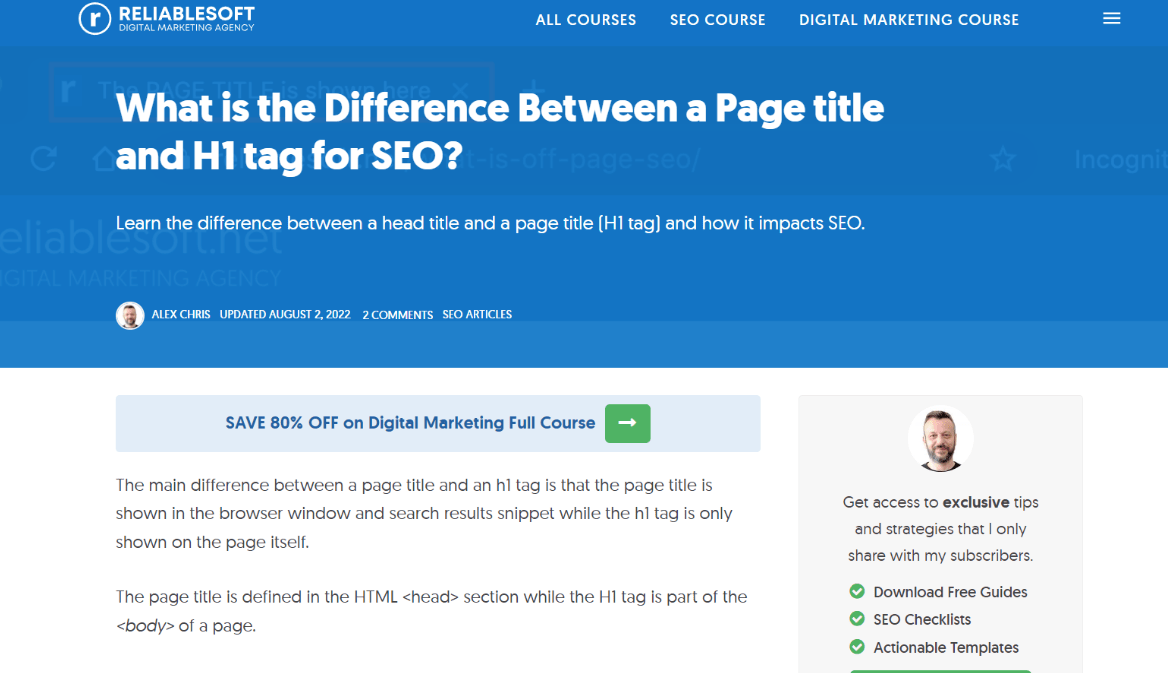
In this image, the headline <h1>What is the difference between a Page Title and H1 tag for SEO?</h1> is the H1 tag that communicates to readers and the bot that the page should contain a comparison between an H1 tag and Page Title.
Title Tag
A title tag refers to the blue links that appear in search results. It shows the title of a web page. Title tag optimization helps the users to get the context of the web page.
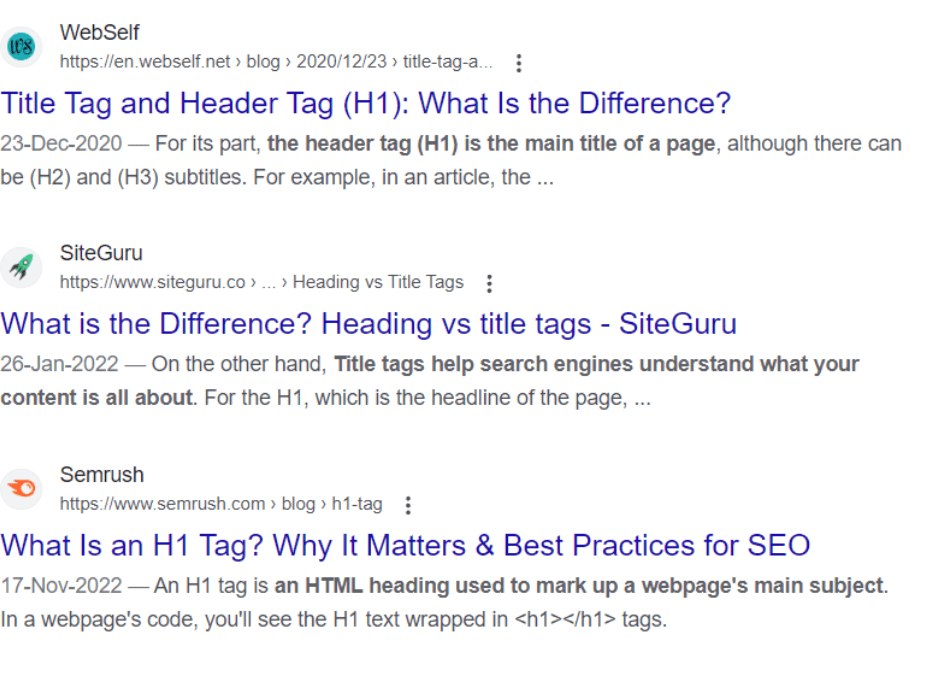
Here, the blue links are the Page Titles that appear in Google SERP when a searcher searches for Page Title vs H1 tag. It is embedded in the page’s code as <title> to mark what the searcher will find on the webpage if he clicks on the link.
You should aim to create headlines that can work as both H1 and title tags to make it easy for the users to get the webpage’s overall message. Even search engines find it easy to rank headlines with the same H1 and title tag.
How Do You Write an SEO-Friendly Headline?
The following ten steps will help you write a click-worthy headline for your blog and get it ranked easily:
- Maintain character limit
- Use relevant keywords
- Use Google Trends for keyword research
- Make it clear to understand
- Include CTA
- Include numbers to suggest a list
- Make it useful
- Create a sense of urgency
- Use emotions
- A/B test headlines
1. Maintain Character Limit
There is no universally accepted character limit for headlines. A study of 100 million of the best headlines across Facebook and Twitter revealed that the ideal headline length should be 11 words and 65 characters.
However, the character limit may vary according to the content format. For example, Google recommends 30 characters for text ad headlines. Instagram allows a whopping 2,200 characters for captions but truncates them to 125 characters after which readers have to click ‘more’ to read further.
Ideally, the title tag of a blog should be around 60-65 characters so that at least 90% is visible in the SERP across any device.
2. Use Relevant Keywords
You may want to incorporate several keywords in the headline to grab the maximum attention. However, this practice can result in a negative user experience or harm your website’s ranking, according to Google.
Instead, use a popular and low-competition keyword and place it near the beginning of the headline. Understand the user intent behind your keyword and utilize semantics to rank for similar keywords.
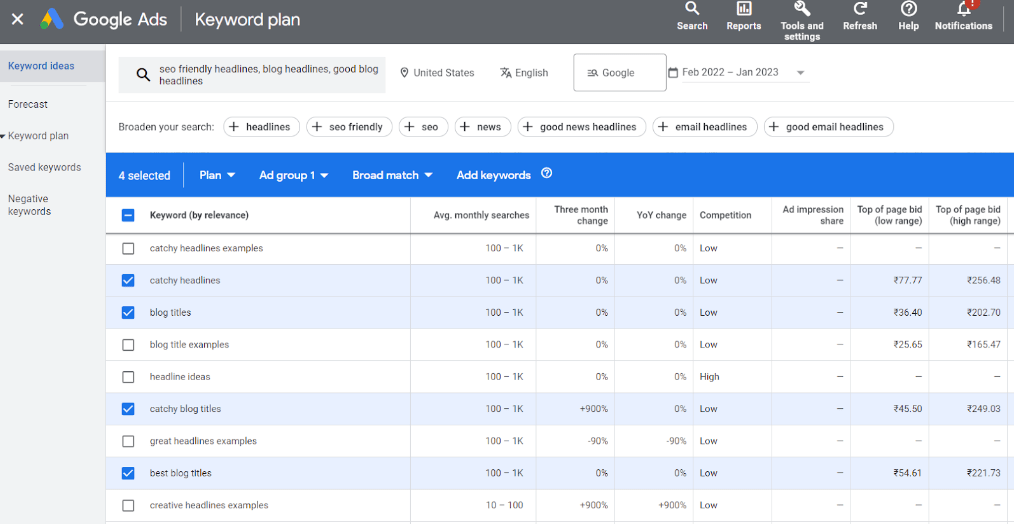
The earmarked keywords in this snippet have 100-1K average monthly searches and low competition. They are more likely to rank on search engines in a shorter time over highly competitive keywords.
3. Use Google Trends for Keyword Research
Google Trends is a popular tool to write SEO content. It shows popular and trending keywords across various languages and regions.
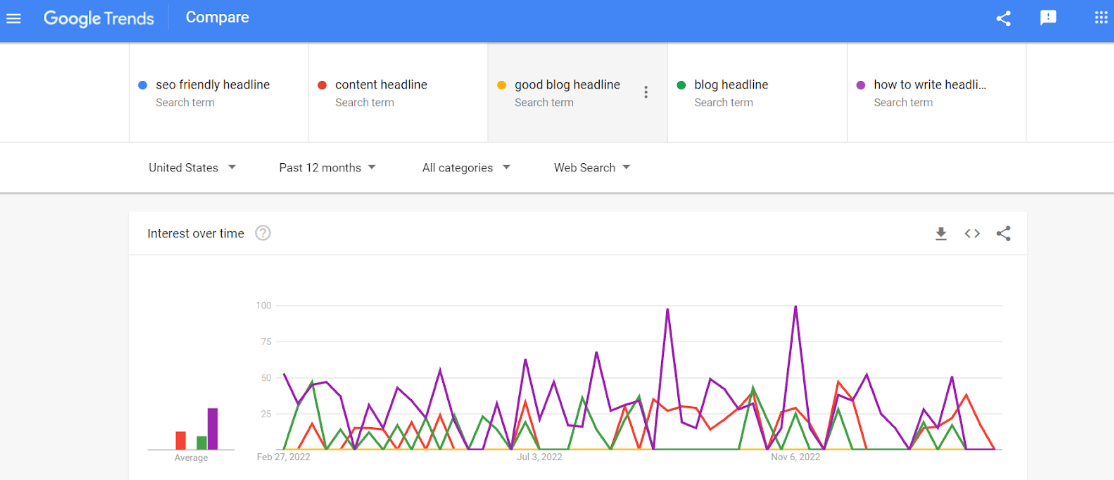
In this image, you can see how your keywords are trending over a period with a clear graphical representation. It helps you strategize your content calendar and target your audience with the right keywords at the right time.
You can leverage these keywords to find out what’s top of mind for your target audience and write a catchy, SEO-friendly headline.
4. Make it Clear to Understand
The target audience should be able to understand the headline without having to decipher the meaning of the words. Hence, when you are writing headlines, keep them as simple as possible to get straight to the point.
Avoid using acronyms, jargon, or obscure words. Be clear, not clever. Use power words such as ‘boost’, ‘increase’, ‘reasons’, ‘steps’, ‘affordable’, ‘tricks’, ‘amazing’, ‘growth’, and ‘useful’ to boost SEO engagement.
5. Include a Call-To-Action (CTA)
A CTA encourages the target audience to take an action. It increases conversion rate, click-through rate, signups, subscriptions, and sales. A headline with CTA immediately persuades the target audience to explore the content’s body.
Examples:
- Buy this e-book now and get 50% off
- Limited-time offer: Get your free watch
CTAs should be powerful enough to make readers want to click. They should content power words like “Buy”, “Grab”, “Try”, “Get”, etc. to convey what benefits your audience will get if they take the action. Also, you can trigger a sense of urgency among your readers with time-bound CTAs like “Offer ends today”, “limited-time deal”, “Black Friday sale”, etc. to make them act fast.
6. Include Numbers to Suggest a List
Numbers in your headings can leap up the click-through rate by 30%! That’s because they are easy and quick to read. They make the content look easily digestible and also take up a lesser character count.
However, make sure that you use a numeral instead of spelling it out. For example, you should write ‘8’ Tips instead of ‘Eight Tips’. This is because a numeral looks more attractive and actionable.
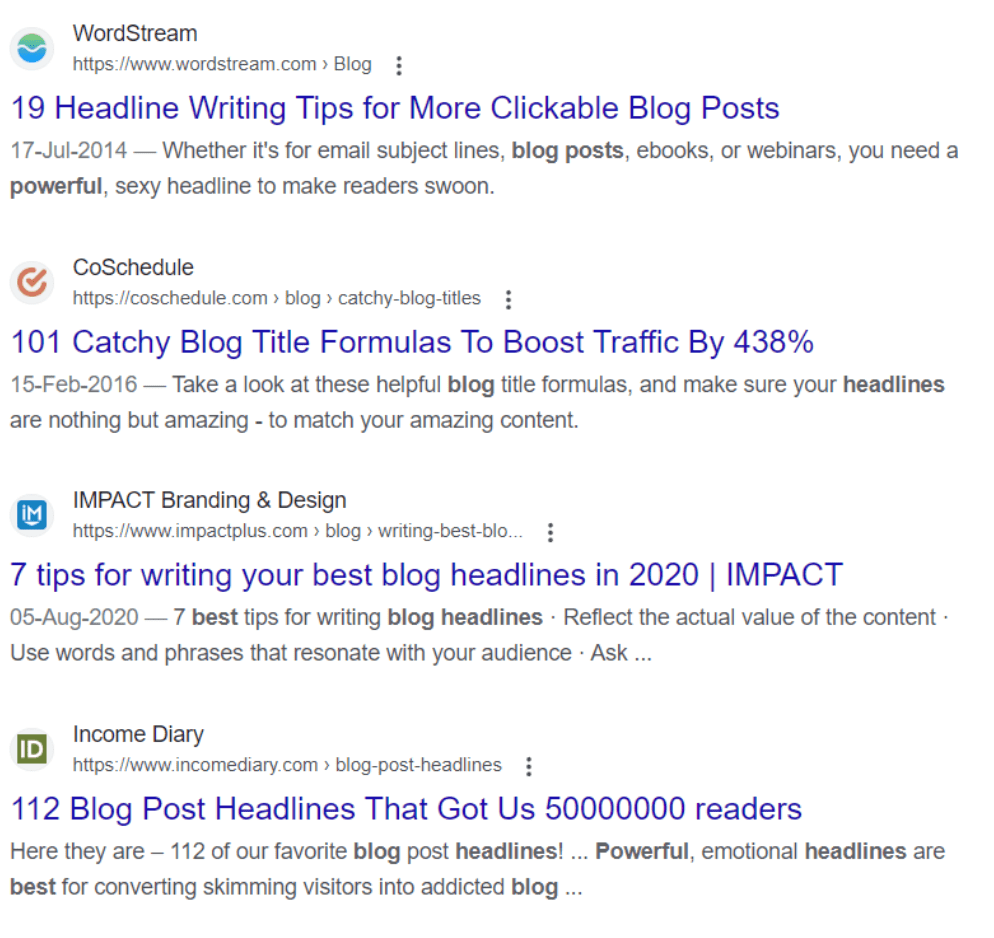
Here, all the headlines start with specific numbers to tell the readers how many tips and formulae will they exactly get from the content. They also suggest a benefit like “boost traffic by 438%” or “Get 50000000 readers” to compel readers to read their content.
7. Make it Useful
A good indicator of SEO-friendly content is that it should offer a value proposition. The headline should indicate the benefits that the target audience will get if they read the content.
Examples:
- 5 Incredible Tips to Plan a Perfect Holiday
- How to Get 100000 views on your Youtube video
These examples clearly tell the readers that they can “Plan a Perfect Holiday” or “Get 100000 views on Youtube videos” using the tips and tricks discussed in the blogs.
With specific benefits, the blog can address the pain points of its audience, offer a solution, and build credibility to attract readers. But at the same time, the headlines should deliver their promise in their content and not be mere clickbait.
8. Create a Sense of Urgency
A sense of urgency in the headline will make the target audience click on the content without thinking twice as soon as it appears in the search engine. This is because such content invokes Fear of Missing Out (FOMO) in them, and they don’t want to ignore it.
Examples:
- 3 Reasons Why You Must Buy Gold This Month
- You Don’t Want to Miss Out on This End-of-the-Season Sale
Create this sense of urgency to encourage users to click on your website.
9. Use Emotions
Emotions are the primary motivators of human behavior. SEO titles with emotions resonate with the target audience more than rational headlines. They trigger their sentiments and make them relatable.
Write headlines that invoke happiness, sadness, humor, anticipation, desire, surprise, or fear to engage the target audience emotionally.
Examples:
- Son’s Reunion with Parents After 5 Years is so Heartwarming (happiness)
- 10 Essential Skills You Need to be a Successful Entrepreneur (desire)
- We Bet You Will Go ROFL After Watching This Video (humor)
Such headlines also show that you have written content for the consumption of readers, and not merely to gain search engine rankings.
10. A/B Test Headlines
A/B testing of headlines refers to creating several headlines to determine the best-performing one. You can run these headlines in a catchy title generator online and find out which one is likely to draw more readers.
A blog and title generator tool like Instoried can help you write effective headlines. It is an AI headline tool that generates appealing and engaging headlines based on the body of the text. It also analyzes the performance of SEO headlines to determine their tone and impact. The impact index enables you to analyze the attractiveness of the headline and whether it will engage the target audience.
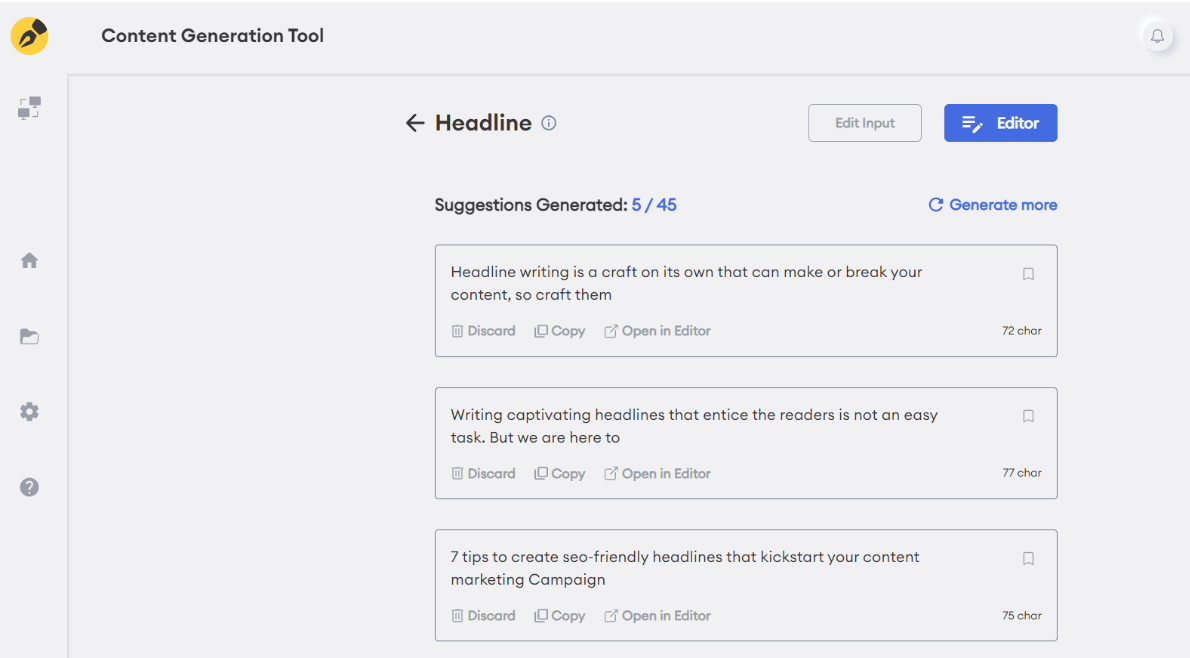
Instoried also offers several other useful features to create unique and engaging content:
- It analyzes the tones (positive, neutral, negative) and emotions in the text of your content to emotionally target the audience.
- It gives the real-time word and phrase-level suggestions to boost content quality and emotional engagement.
- It has an in-built plagiarism tool to detect duplication.
Write a Killer Headline
A headline is the first impression of your content. It should be SEO-friendly so that the content has a better chance of ranking higher in search engines.
You can incorporate SEO elements in the headline by maintaining a character limit, using relevant keywords through Google Trends, making it clear to understand, including CTA and numerals, creating a sense of urgency, and adding emotions.
Do not forget to A/B test the headlines before you publish the content. Lastly, remember to use an SEO headline checker tool to create an impactful headline.
Additional Reading: